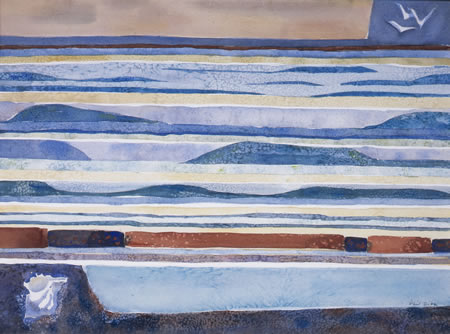
An exhibit of merely a dozen canvases at the Laguna Art Museum offer ample evidence of artist Phil Dike’s skill and stylistic versatility.
Selected by historical art curator Janet Blake from the Diane and E. Gene Crain Collection, these paintings lift Phil Dike out of the California Scene Painting realm and into semi-abstraction, a fertile territory between the real and imagined.
The exhibition “Phil Dike: The Wave Series and Malibu Set Series, 1968-1981,” mostly water colors with a smattering of oil paintings, are taken from a trove of his “Malibu Set” and “Wave” series.
The museum show is up until Sept. 27, but a second local exhibition of Dike’s earlier work at the Laguna College of Art and Design closes Saturday, Aug. 15.
In the museum exhibit, Dike’s “Wave Variation” and “Wave Echo,” with their linear compositions of shades of blue, immediately suggest waves but leave viewers to recollect their own impressions of the ocean and surrounding life like birds, shells and the flotsam left at low tide. Throughout the Malibu Series, Dike delves into various ways of presenting the figure, some clearly delineated, others cleverly suggested.
Keen eyes will also note the random shapes within painted fields and shapes. Blake explained he achieved those by sprinkling table salt on wet paint and carefully removing it once the paper was dry.
“If you look at Phil’s career, you see how he changed every decade. During the ‘30s, he joined the bandwagon of California Scene Painting, but from the ‘40s on his shapes became more and more abstracted,” said Blake, who is working on a large retrospective of Dike’s work for 2017.
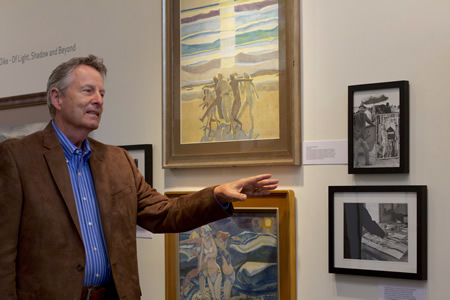
The second exhibit, “Of Light and Shadow and Beyond,” is another small but illustrative exhibition of Dike’s early and late works at the Laguna College of Art and Design, which was curated by Andrea Harris-McGee.
At a museum talk earlier this month, Dike’s son, Laguna Niguel-based urban designer and landscape architect, Woodward (Woody) Dike, described his father’s multi-faceted life. In a later interview, he revealed, for example, that his father had also been a prolific poet and insightful philosopher. Woody Dike, 72, gained artistic chops by working for iconic furniture designer Sam Maloof, whose career, like that of his father, blossomed in Claremont.
A small cabinet contains pages of Phil Dike’s sketchbooks, which he used to pre-arrange compositions of paintings as well as a teaching tool for his students. “While composing his paintings, my father was preoccupied with principles of organisms moving in space, with figures and movement of objects such as the sailboats in ‘Big Corona’ or ‘Beach Scene with Bluffs,” said Woody Dike.
He recollected that the battered tin water container also on display had accompanied his father on sojourns to Paris, where he honed his skill at making lithographs, and to various locales ranging from Corona del Mar to Cambria and San Simeon. He recalls summers during the ‘40s and ‘50s in Corona del Mar where his father conducted the Brandt-Dike Summer School of Painting with his friend Rex Brandt as a magical time of having Brandt and Joan Irving and other artist contemporaries acting as his mentors and surrogate parents.
He explained his father’s preoccupation with the process of painting while the finished product had little value for him. “Once he was finished, it was on to the next. He never saw commercial value in the paintings, just enjoyed the high of creating,” he said. “When he painted, his hands took over from his brain, and once his hands stopped moving, the painting was done.” He added that his mother Betty, a ceramicist in her own right, carefully stored the paintings for posterity.
Instead, Phil Dike supported his family by teaching at the Chouinard Art Institute, his alma mater,
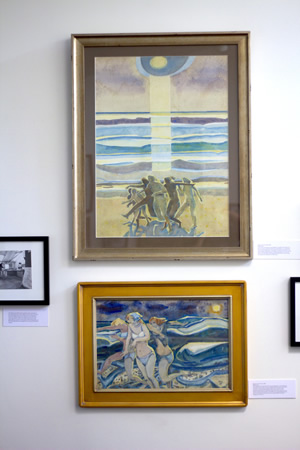
and later at Scripps College and Claremont Graduate School. “I think my father enjoyed his students even more than his family. The energy he poured into teaching came back to him,” said Woody Dike.
He emphasized that his father’s studio was a sanctuary where he concentrated on his art, surrounded by objects that inspired him and which, in somewhat abstracted form, found their way into his compositions.
In 1935, the same year Mickey Mouse appeared in Technicolor, he began working as a color coordinator for Walt Disney Studios where he had a hand in creating “Snow White” and “Fantasia.” The latter’s atmosphere made its way into later paintings. “My father was always a little spooked by the area around Cambria. To him the woods seemed enchanted,” recalled Woody Dike.
“Whether my father’s paintings are representational scene paintings, figurative or semi-abstract, there always seems to be a sense of movement and a little work for viewers to use their own imagination and interpretation,” said Woody Dike.
In 1981, his father began to struggle with Alzheimer’s disease but continued to paint, often modifying older works, said his son. Born in 1906 in Redlands, he died in 1990 at age 84.


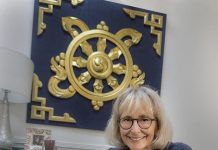

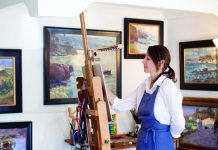
[…] Two years ago, Blake organized a preview exhibition of roughly a dozen canvasses from the Wave and Malibu Set series (1968-1981) that gave viewers an impression of his later work, semi-abstracted or abstracted and mostly of the sea. At that time the Laguna College of Art and Design also featured a show of Dike’s paintings, sketchbooks and memorabilia titled “Of Light and Shadow and Beyond.” […]